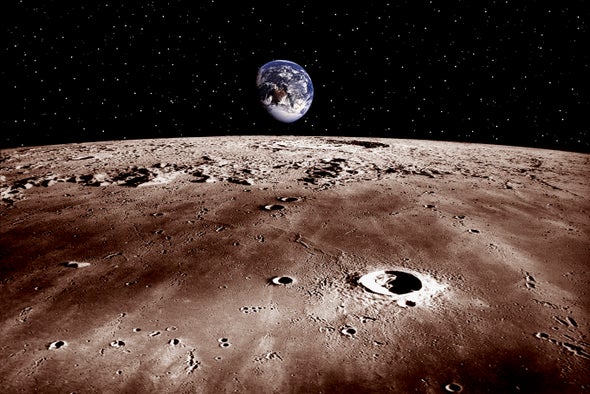(单词翻译:单击)
听力文本
This is Scientific American's 60-second Science, I'm Christopher Intagliata.
The Apollo missions brought back 842 pounds of rock and soil from the moon... nearly 2200 different samples. But there's one sample that planetary scientist Meenakshi Wadhwa says is the most interesting of all: "Apollo 1-0-0-8-5."
Neil Armstrong collected it on Apollo 11.
"He was about to step back into the lunar module and he turned around and had this rock box and he saw little spaces in there and he knew that these geologists on earth would be just so excited to study these materials, he just scooped up I think nine scoops of soil that he put into the box."
It became one of the most well studied samples of the Apollo missions, she says. And a geologist named John Wood, at the Smithsonian, noticed white flecks of rock in the soil... which he identified as a rock type called anorthosite. And it clued him in to the moon's ancient past.
"And this was quite a leap of imagination but he proposed that the whole of the moon had at one time in the past, you know, somewhere close to 4.5 billion years ago, been almost covered with a global magma ocean. You know, an ocean of lava. And so this was a revolutionary idea at the time. Because people had thought the moon had formed cold, so it completely changed our idea how the moon formed, how the terrestrial planets formed, like the Earth as well. You know, it really changed a lot about our understanding of planetary science."

But Wadhwa has a second—and more personal—reason to appreciate this sample.
"I met my husband because of this rock. My husband is Scott Parazynski, he was with NASA as an astronaut for 17 years, from 1992 to 2009. And after his retirement from NASA, he was a mountaineer as well. And he had always aspired to climb Mount Everest."
Scott's boyhood heroes were Neil Armstrong, and the climber Edmund Hillary, who made the first confirmed ascent of Everest with his partner Tenzing Norgay.
"In honor of them, he wanted to take a moon rock from Apollo 11 to the top of Mount Everest, and to bring back an Everest summit rock."
At the time Wadhwa was the chair of the NASA committee that grants access to the samples for scientific purposes. But this request, she says, was definitely out of the ordinary.
"I just remember it because it was a really funny discussion in the committee room, you know, hey, what if that moon rock falls down a crevasse, you know, and Scott would be going down with that moon rock of course!"
But Scott made it to the top. Wadhwa never met him, and moved on from the lunar sample committee. But then, a year or two later, she saw a friend suggestion pop up on Facebook: you might know Scott Parazynski.
"And I reached out to him and I said, 'hey, how did that expedition go and did you return the moon rock to NASA?' And he sent me this note back, 'Well, you know, actually I didn't send the moon rock back to NASA. I actually sent it back to the International Space Station along with a Everest summit rock. And if you ever happen to be in Houston I'd love to meet you and thank you for making that possible.' And so I happened to meet him… and that was it. You know, that’s how we met."
And so Neil Armstrong's last-minute scoop of moon dust brought two people together here on Earth... and upturned our understanding of how the moon—and the Earth itself—got here.
Christopher: There's something in there, 'One small scoop for a man...'
Meenakshi: "Yeah! A magma ocean for mankind. Yeah, exactly. 'One small scoop for a man, a magma ocean for mankind.'"
Thanks for listening for Scientific American — 60-Second Science. I'm Christopher Intagliata.
参考译文
这里是科学美国人——60秒科学系列,我是克里斯托弗·因塔格里塔。
阿波罗任务从月球上带回了842磅岩石和土壤,近2200种不同的样本。但行星科学家米纳克什·瓦德瓦说,其中有一份样本是最有趣的:“阿波罗1-0-0-8-5”。
尼尔·阿姆斯特朗在执行阿波罗11号任务时收集。
“他当时正要回到登月舱,他转过身来,手上拿着装着石头的盒子,他看到里面还有些空间,他知道地球上的地质学家会非常兴奋地研究这些材料,于是他就挖了几勺月球土壤装进了盒子里,我想大概是9勺。”
她说,这成为了阿波罗任务中研究得最充分的样本之一。史密森学会的地质学家约翰·伍德注意到了土壤中有白色斑点的岩石,他认定那是一种名为斜长岩的岩石类型。这使他详细了解了月球的远古历史。
“这是想象力的巨大飞跃,但他提出,整个月球大约在近45亿年前,几乎被岩浆海洋完全覆盖。就是那种熔岩海洋。这在当时是个革命性的想法。因为人们一直认为月球是冷形成的,所以这彻底改变了我们在月球形成方式上的观点,也改变了我们对类地行星形成方式的观点,这包括地球在内。这真的极大地改变了我们对行星科学的理解。”
但瓦德瓦感谢这个样本还有第二个原因,也是更私人的原因。
“我因为这块岩石遇见了我的丈夫。我丈夫是斯科特·帕拉兹斯基,他从1992年到2009年,在美国国家航空航天局(简称NASA)做了17年宇航员。从NASA退休后,他还成为了登山运动员。他一直渴望登上珠穆朗玛峰。”
斯科特少年时代的英雄是尼尔·阿姆斯特朗和攀登者埃德蒙·希拉里,后者和同伴丹增·诺盖是首批成功登顶珠峰的人。
“为了纪念他们,他想把阿波罗11号带回来的一块月球岩石带到珠峰峰顶,然后将珠峰峰顶的岩石带回来。”
当时,瓦德瓦是NASA一个委员会的主席,该委员会授权以科学目的接触样本。她说,这一请求绝对不同寻常。
“我之所以记得这个请求,是因为我们在委员会会室进行了非常有趣的讨论,我们说到‘嘿,要是月球岩石掉到裂缝里怎么办?斯科特当然会跟着那块月球岩石一起掉下去!’”
但斯科特成功登顶了。瓦德瓦从未见过他,并离开了月球样品委员会。但一两年之后,她看到脸谱网上弹出了好友推荐:你可能认识斯科特·帕拉兹斯基。
“我联系到他并问道:‘嘿,那次探险怎么样?你把月球岩石还给NASA了吗?’他回复我说:‘其实我并没把月球岩石还给NASA。我把它和珠峰峰顶的岩石一起送回了国际空间站。如果你刚巧在休斯敦,我想和你见面,感谢你促成这件事。’我碰巧遇到了他……就是这样。我们就是这样遇见彼此的。”
可以说,尼尔·阿姆斯特朗最后一刻挖的几勺月球尘土,让地球上的两个人走到了一起,还颠覆了我们对月球以及地球本身是如何形成发展的理解。
克里斯托弗:有句话说的是:‘一个人的一小勺,’
米纳克什:“对!是人类的岩浆海。对,没错。‘一个人的一小勺,是整个人类的一大片岩浆海。’”
谢谢大家收听科学美国人——60秒科学。我是克里斯托弗·因塔利亚塔。
译文为可可英语翻译,未经授权请勿转载!
重点讲解
重点讲解:
1. turn around 转动;转身;
I felt a tapping on my shoulder and I turned around.
我感到有人拍了一下我的肩膀,于是转过身去。
2. scoop up (敏捷地)抱起,拿起,捡起;
Use both hands to scoop up the leaves.
用双手捧起叶子。
3. in honor of 为向…表示敬意;
The United Nations has issued a stamp in honor of Captain Alfred Dreyfus.
联合国发行了一枚纪念阿尔弗雷德·德雷富斯上尉的邮票。
4. out of the ordinary 不寻常的;非凡的;特殊的;
The boy's knowledge was out of the ordinary.
这个男孩懂得的知识非比寻常。


